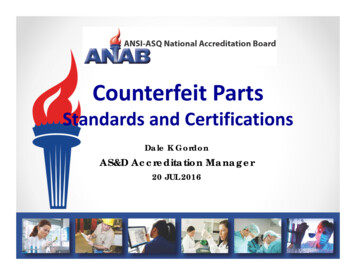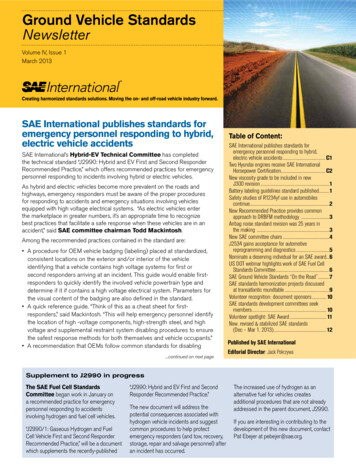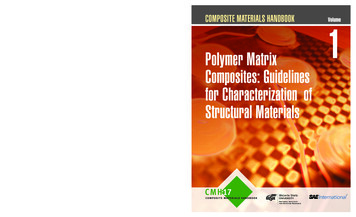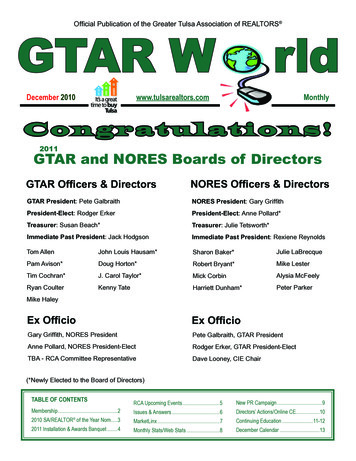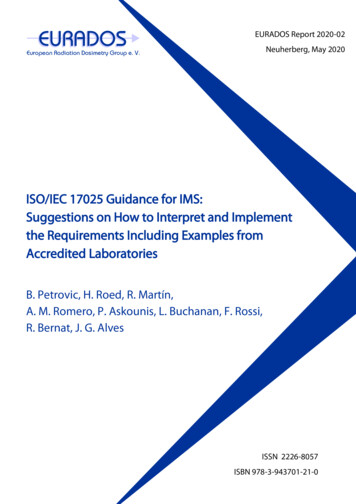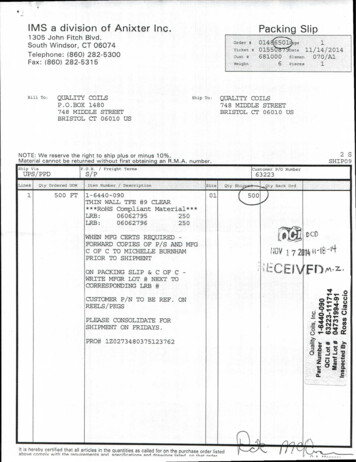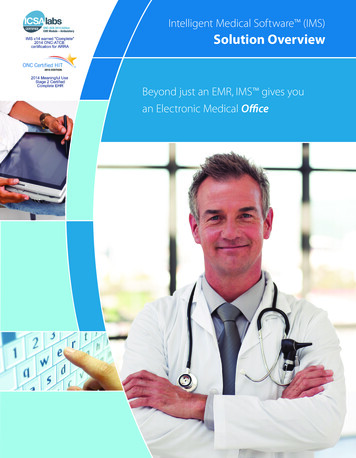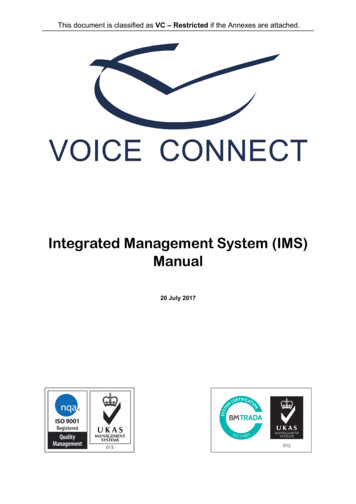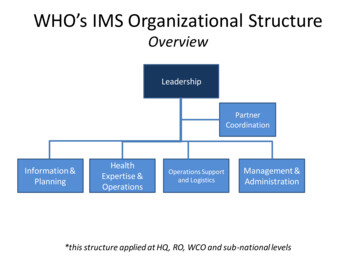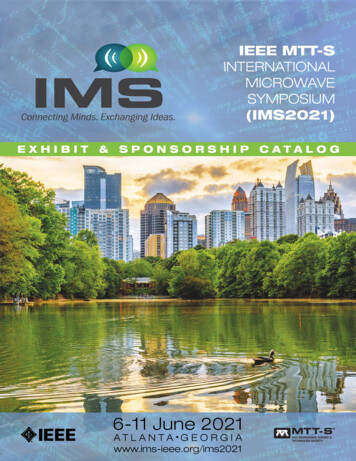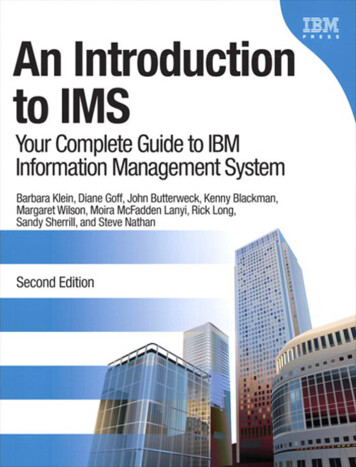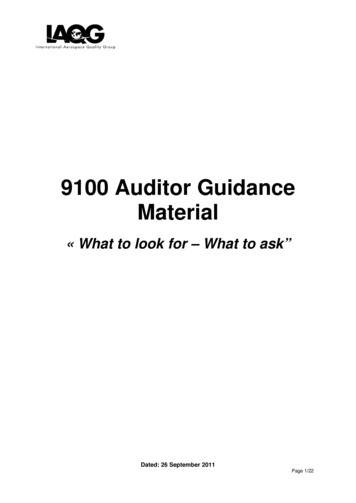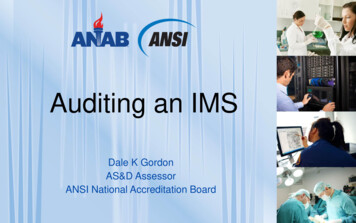
Transcription
Auditing an IMSDale K GordonAS&D AssessorANSI National Accreditation Board
What is IMS?INDIANAPOLIS MOTOR SPEEDWAY?2
What is an IMS?Integrated Management SystemIAF MD 11A single management system managing multiple aspects oforganizational performance to meet the requirements of more thanone management standard/specification, at a given level ofintegration.When an organization uses a single MS?The level to which an organization uses one single managementsystem to manage multiple aspects of organizational performanceto meet the requirements of more than one management systemstandard/specification. The level of integration may range from acombined system adding separate management systemsprocesses for each set of audit criteria/standard, to an IntegratedManagement System, sharing in single system documentation,management system elements, and responsibilities.3
Why an IMS?The Integrated Management System (IMS) integrates all of anorganization's management systems and elements into onecomplete system. That system will: Meet requirements of several standards with one set of policies and procedures Capable to Audit more than one system at a time to save money and resources Improve organizational efficiency by removing duplicated tasks Clearly defined roles and responsibilities while highlighting common objectives Supports standardization between multiple business locations Make continuous improvement more effective Providing a common documentation structure4
When to have an IMSAn Integrated Management System isrelevant to organizations that: Have two or more managementsystems in place with or withoutcertification Have certification for two or more external standards Have other External or Internal Requirements into thebusinessNote:External requirements Standards, Laws, Regulations, etc.Internal Requirements Internal needs of the business5
What Are the Considerations forAuditing an IMS?Level of IntegrationAudit PlanAudit TeamAudit ProcessCertificationSurveillance and RecertificationSuspension, Reduction, Withdrawal6
IMS Level of IntegrationThe level of integration of an organization is characterized by:1.2.3.4.5.6.7.An integrated approach to policy and objectives;Integrated management support and responsibilities.An integrated approach to systems processes;An integrated documentation set, including workinstructions sufficient to cover all requirements;An integrated approach to internal audits;Management Reviews that consider the overallbusiness strategy and plan;An integrated approach to improvement mechanisms, (correctiveand preventive action; measurement and continual Improvement);and7
IMS Level of IntegrationCommon clausesand requirementsContractual andregulatory reqmtscan be includedComplexity of theof the organizationScope(s) of theorganizationLevel of Org’ssystem’ integrationCBs must determinelevel of IntegrationNOTE: The organization can have common vs different scopes for each standard and still have anintegrated system, but they must be separate certifications if different.8
An IMS Audit PlanAudit Duration (addition and reduction)depends on Level of Integration and scheme rules(AS9104-1, Automotive, TL9000 etc.) and IAF MD 112 MethodsStandard Audit ApproachExtended Audit Approach*AS9104-1 (currently) requires separate certificationsand audits if there are different scopes including ISO9001AQMS standards would be audited separately(Resolution 154)9
An IMS Audit PlanCurrent AQMS Approach (per AS9104-1)On site audit time for the AQMS standard shall not be used to auditany of the other management system requirements.No reductions in the 9104-001 calculated AQMS audit duration shall beapplied and the associated audit reports shall clearly indicate timeused for the AQMS portion of the audit.The CB shall add time for the additional management system auditactivity in accordance with IAF MD 11 and, upon request, provideobjective evidence that no AQMS audit duration was used to audit theadditional management system standard(s).10
An IMS Audit PlanStandard Audit Approach (per MD11)Calculate the required audit time for each standard separately (applying all relevant factorsprovided in the application and/or scheme rules for each standard and calculate the starting point forduration of the audit adding the sum of the individual parts (e.g. T A B C).The factors for reduction shall include but are not limited to:i) The extent to which the organization’s management system is integrated;ii) The ability of the organization’s personnel to respond to questions concerning more than onemanagement systems standard; andiii) The availability of auditor(s) competent to audit more than one management systemstandard/specification.The factors for increases shall include but are not limited to:i) The complexity of the audit of an IMS compared with single management system audits.Audit of an IMS could result in increased time, but where it results in reduction, it shall notexceed 20% from the starting point time (T).NOTE: Proposed for AQMS and other MS Standards11
An IMS Audit PlanExtended Audit Approach (per MD11)Calculate the required audit time for each standardseparately (applying all relevant factors provided for by the applicationand/or scheme rules for each standard and calculate the duration ofthe audit by taking the longest audit time for a single standard then add50% of the audit time of each additional standard T A 0,5 B 0,5 C with A B and CIf EAA is used, a planning session with the client to fully understandthe IMS, and its level of integration is required. Records of the planningsession shall be maintained. (Annex 1)NOTE: proposed for AQMS only (AS9100, AS9110 and AS9120)12
An IMS Audit TeamRegardless of the Approach or Number of StandardsThe audit will be conducted by one or more auditors.The auditors are competent for one or more management systemstandards/specifications relevant for the scope of the audit.The audit team as a whole shall satisfy the competence requirements,established by the Certification Body, for each technical area, as relevant foreach management system standard/specification covered by the scope of theaudit of an IMS.The audit shall be managed by a team leader, competent in at least one of theaudited standards/specifications (ISO/IEC 17021-1:2015 Note in 9.2.2.1.2).When using Extended Audit Approach (EAA), the audit team leader shall haveadditional competence on applying the EAA methodology (Annex 1).13
An IMS Audit ProcessEAA IMS Audits require:A mandatory planning session prior to the audit by the lead auditor.The lead auditor only will audit the clauses 4, 5, 6, 9 and 10 (of management systemstandards following the High Level Structure) of the IMSAudit reports shall be integrated for both approaches, unless required otherwise, withrespect to the management systems audited. Each finding raised in an IMS report shallbe traceable to the applicable management system standard(s).Nonconformance to one common requirement of the IMS is applicable to the entire IMS.A nonconformance is to one standard specific requirement, then it impacts the IMS inregard to that standard only.AQMS audit results/report (9101) shall not be combined with the audit results for othercertification schemes (e.g. ISO 14001) in one audit report. If required, an additionalseparate audit report should be generated for the combined standard(s).14
Certification of an IMSDuring the Stage 1 the lead auditor shall confirm the level of integration of the IMS and the outcome of theplanning session in case of EAA. The Certification Body shall have a process to review and modify, the auditduration.The EAA planning session is conducted, prior or during Stage 1 or prior to a subsequent audit using EAA at firsttime and afterwards when there are major changes in the organization or the IMS of the organization there shallbe planning session. ICT may be used for the planning session in accordance with MD4.The Planning session reviews the following inputs:- Scope of the activities of the company- Scope of the IMS and its components- Processes and structure of the organization- Level of Integration of the MS- Auditor competence requirementsThe following outputs are expected:- Confirmation of full integration of the IMS- Confirmation of audit duration and audit team competence- Audit plan15
Surveillance / Recertification of an IMSThe Certification Body shall confirm that the level ofintegration remains unchanged throughout thecertification cycle to ensure that the established auditdurations are still applicable. The details of thisconfirmation will be included in the audit records.16
Suspension and Withdrawal of an IMSPer IAF MD 11If certification to one or more management systemstandard(s) is subject to suspension, reduction orwithdrawal, the Certification Body shall investigatethe impact of this on the certification to othermanagement system standard(s).17
To IMS or Not to IMS, that is the?One Company – Multiple RequirementsAS9100, ISO 14001, ISO 45001, etc.One Company – Multiple MarketsAS9100, ISO 9001, ISO 13485, etc.One Company - Multiple Sites with Same ScopesAS 9100, AS9110 and AS9120One Company - Multiple Sites with Different ScopesAS 9100, AS9110 and AS9120One Company – Multiple sites with Multiple Markets/RmqtsAS9100, ISO 9001, ISO 13485, ISO 14001, ISO 4500118
Resources19
20
21
AS9100, ISO 9001, ISO 13485, etc. One Company - Multiple Sites with Same Scopes AS 9100, AS9110 and AS9120 One Company - Multiple Sites with Different Scopes AS 9100, AS9110 and AS9120 One Company –Multiple sites with Multiple Markets/Rmqts AS9100, ISO 9001, ISO 13485, ISO 14001,
